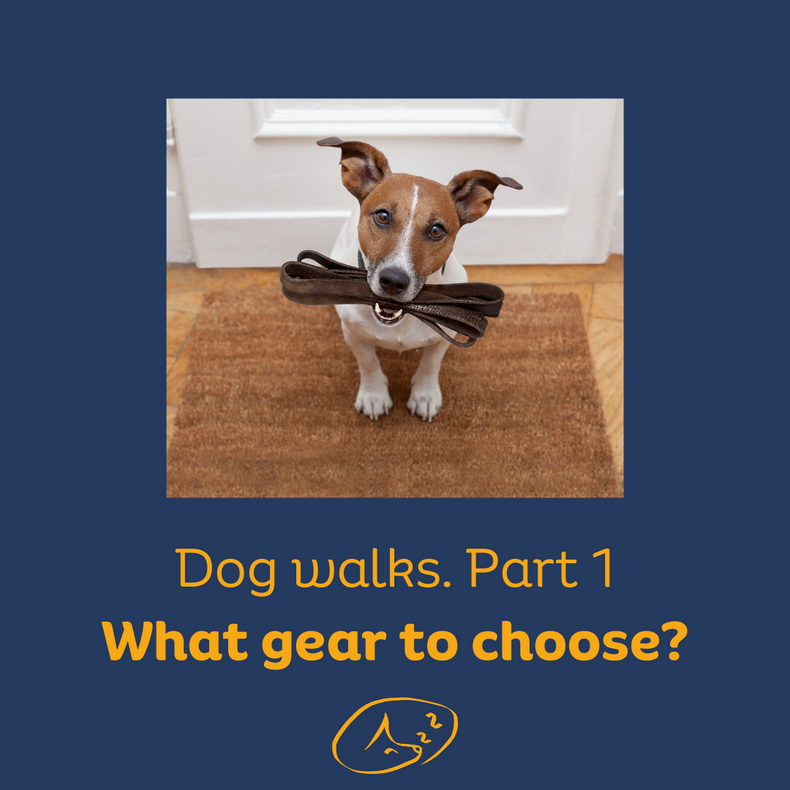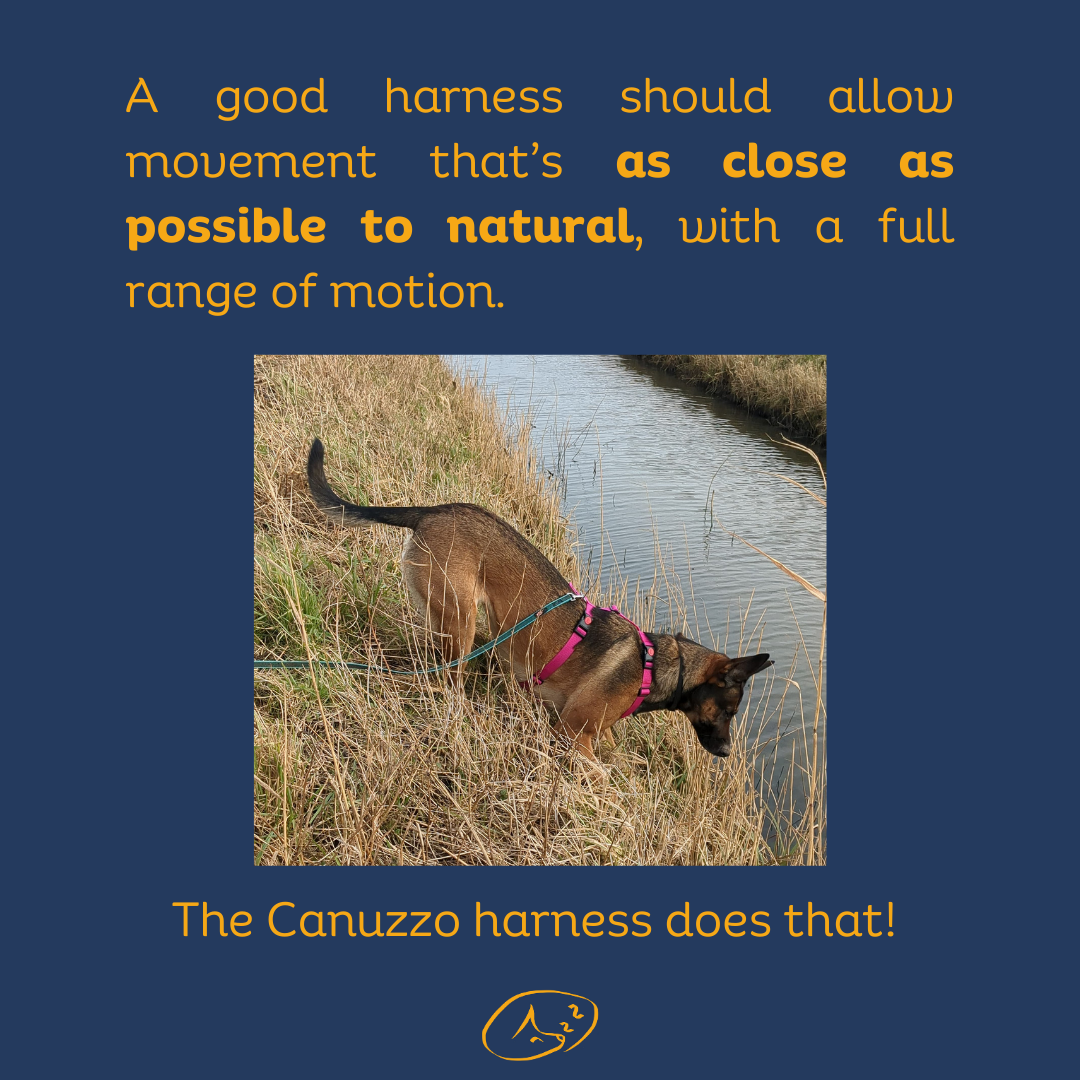Maybe you already noticed — there are so many ways to organise walks with your dog. However, not all of them are beneficial to your dog’s brain and body! So how to make sure your walks are contributing to your dog’s overall health? In the next three articles, we will cover three most important elements of a good walk:
Choice (movement, moving away, where to go)
What gear to choose?
Imagine yourself going for a hike. Which clothes and shoes do you choose? Those that are comfortable, of course. Wearing uncomfortable clothes will affect your whole experience: your mood, your physical state, and likely your communication with hiking companions.

Dogs are like us in many ways, and this is no exception — dogs want to feel comfortable too. At Canuzzo we know that comfort should not come at the cost of safety. A well-fitting harness and a long-enough leash (3 meters / 10 feet +) will keep your dog safe and healthy.
Healthy how? — a great question! Let’s explore this in more detail:
A dog harness must let the paws move freely and prevent soft tissue damage. We want to achieve a healthy, natural gait, similar to a dog who doesn't wear anything.
- If you pay close attention, you will quickly notice that most harnesses out there restrict shoulder movement. A proper harness should have a Y shape at the front and leave the shoulders completely free. There needs to be enough space for elbow movement too. The tip of the Y-triangle should sit on the sternum bone to help prevent soft-tissue damage. You will feel the sternum bone right away if you touch the chest area of your dog.
- The dog’s neck is not a spot for leash attachment. The neck of the dog hosts the thyroid, nerves, blood vessels, trachea, and many other vital organs. All of them can easily get damaged with a sudden pull on the leash. And no dog is a robot (even trained ones), so pulls will definitely happen. You can put a collar on your dog to attach a silent address tag, but do not connect a leash to a collar.*
- The length of leash makes a difference too. Check out this study, for example. A longer leash allows your dog to move freely, communicate more effectively using their body language and feel like they have more choices (to move away or approach something, for example). Each of these things have major impact on wellbeing.
- Please make sure you choose a simple, non-retractable lead to prevent potential injuries and avoid teaching your dog to walk on a tense leash. Handling a simple long line takes a bit more work, but greatly pays off in safety and dog behaviour. With a relaxed “smiling” leash, your dog will feel more relaxed too.
Here at Canuzzo we offer only the gear that will keep your dog safe and healthy.
Dogs that pull
If you are afraid that your dog will start pulling more if you put them in a harness and give them a longer leash, we feel you.
However, there is nothing to worry about. Harnesses do not cause pulling. Very often, high stress and previous learning does. As behaviour specialists, time and time again we see that dogs pull less once they feel more comfortable and relaxed. With our clients, we start training the loose leash walking only once we have dogs wearing a well-fitted harness attached to a longer leash.
What else should you know about dog walking gear?
When choosing the right harness and leash, there are some additional things to consider:
- Many dogs do not like things going over their heads, it’s a simple need for safety. We can make our dogs feel more safe by choosing a harness with additional clips on the front. So that putting the harness on and off feels more pleasant.
- The same about weight — there are lots of dogs who will not like something heavy on their body. Selecting a lighter harness and leash can make a big difference. Have a look at this customer review for the Canuzzo lightweight leash:

- Does a harness need padding? We believe that padding is not necessary. As a result of our education on dog anatomy and movement received from world-renowned experts in the field, and through extensive observations, we came to believe that harnesses with padding restrict movement. Hear us out:
Dogs’ shoulder blades have a very wide range of motion. When a dog is extending their front leg forwards, the shoulder blade comes significantly forwards too. In addition to that, most dogs have narrow chests, and the padding easily gets in the way of a natural limb extension. If you want to get into the details of dog movement, we recommend the book “Dogs in Motion” by Prof. Dr. Martin S. Fischer and Dr. Karin E. Lilje.
We have designed the Canuzzo gear with all these points in mind to provide the best experience to you and your dog at accessible prices — check it out in our online store.
We hope that this article has given you a good idea of which equipment to select for your walks. If you are interested to learn more about this topic, we wholeheartedly recommend exploring the Smiling Leash website — you will find lots of great tips and information about making your dog walks truly enjoyable.
Additional resources:
Nordic Education Center for Ethical Dog Training
*References:
- Pauli, Amy M., et al. "Effects of the application of neck pressure by a collar or harness on intraocular pressure in dogs." Journal of the American Animal Hospital Association 42.3 (2006): 207-211.
- Carter, Anne, Donal McNally, and Amanda Roshier. "Canine collars: an investigation of collar type and the forces applied to a simulated neck model." Veterinary Record 187.7 (2020): e52-e52.




